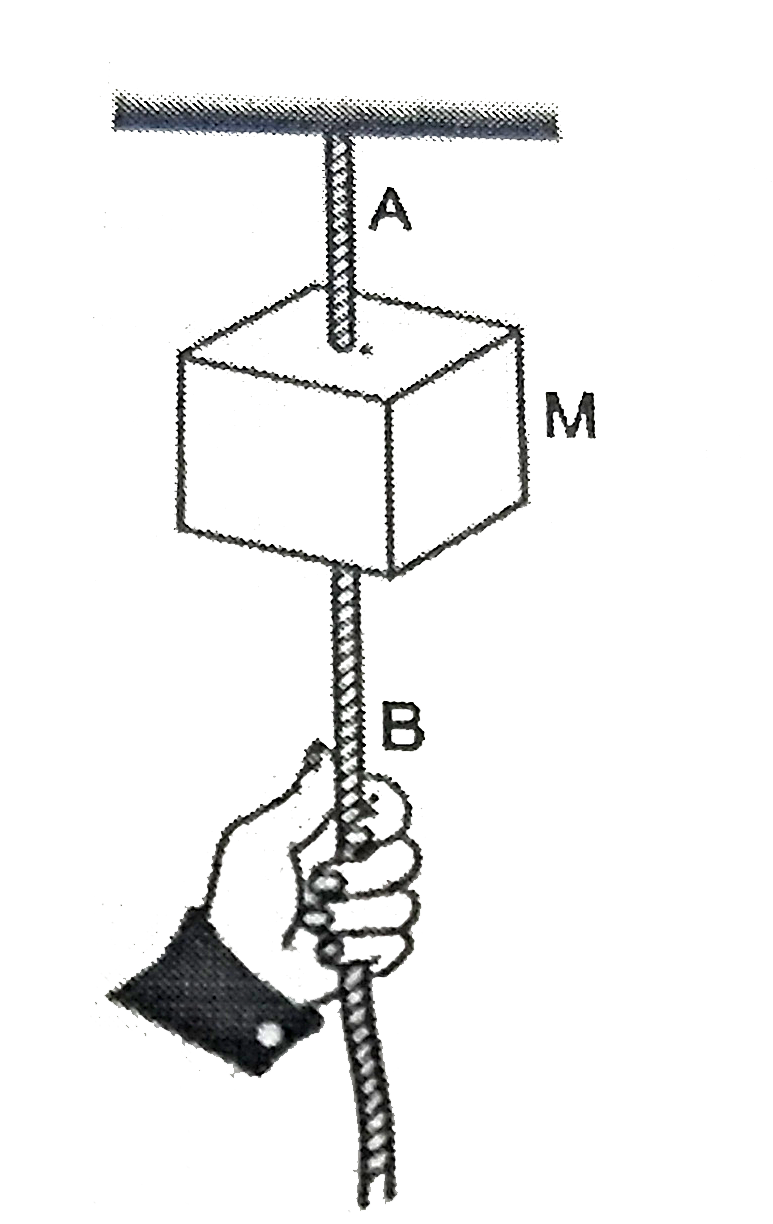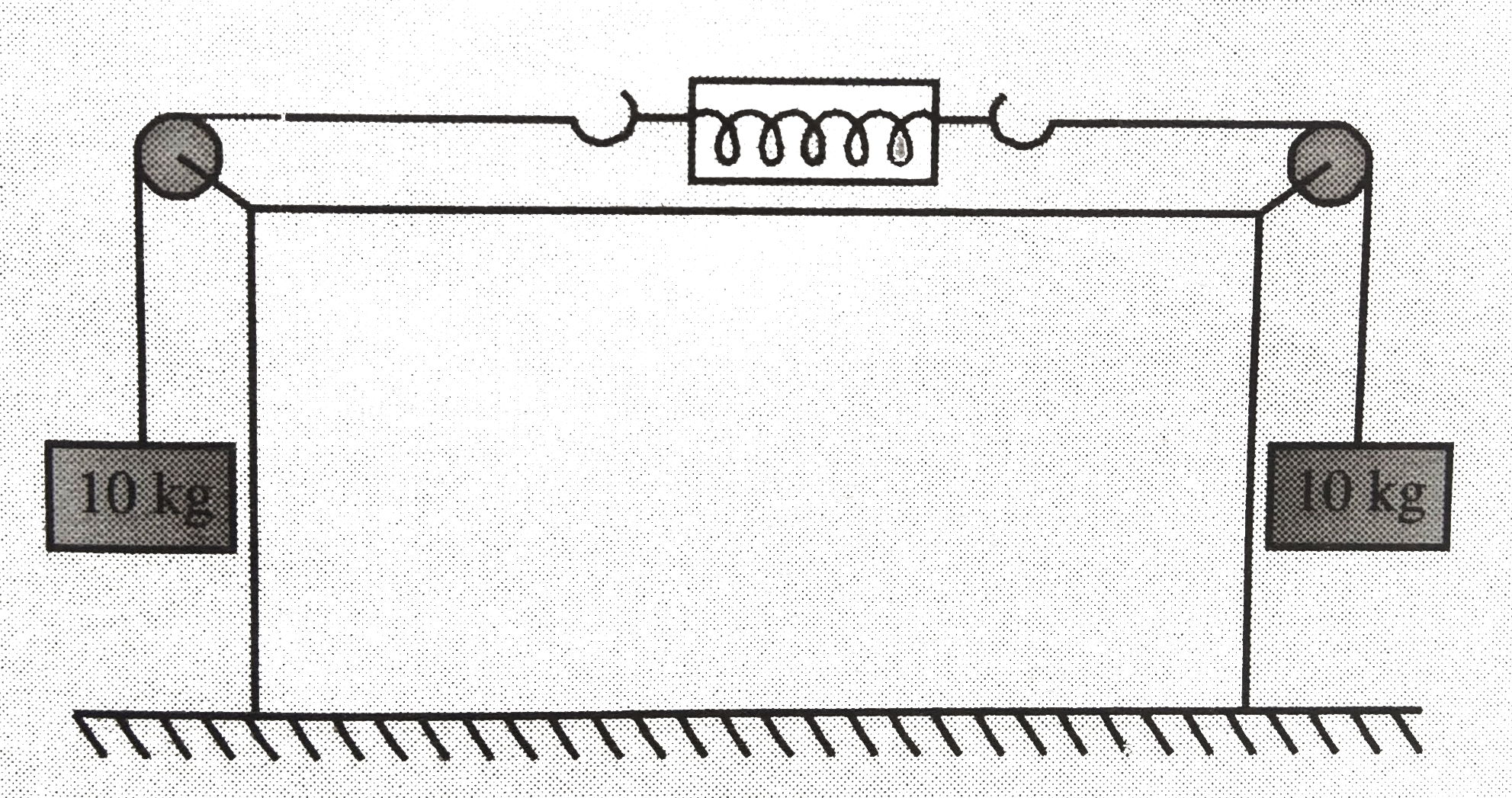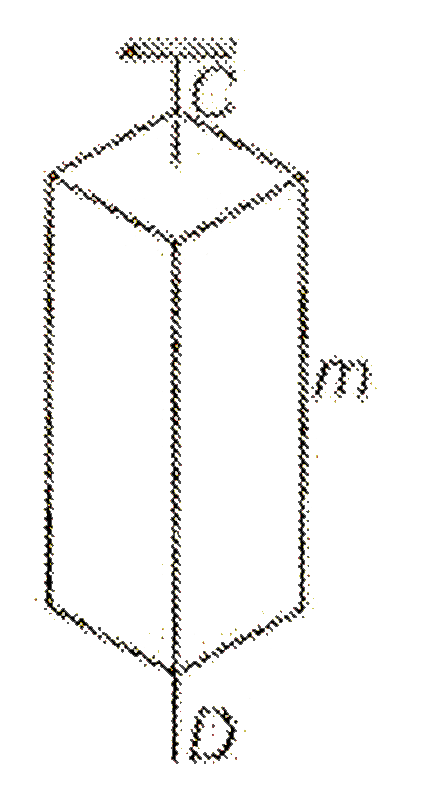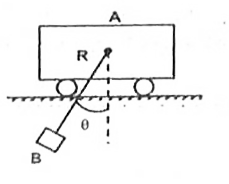A block of mass M is supported by a cord C from a rigid support, and another cord D is attached to the bottom of the block. If D is given a sudden jerk D breaks But if D is pulled steadily, cord C breaks. Why ?
To understand why cord D breaks when given a sudden jerk, while cord C breaks when D is pulled steadily, we can analyze the forces acting on the block and the cords in both scenarios.
1. Identify the Forces Acting on the Block:
- The block of mass M is subjected to two forces: the gravitational force acting downward (Mg) and the tension in cord C acting upward (T_C).
- When cord D is attached to the bottom of the block, it also exerts a tension (T_D) on the block.
2. Scenario 1: Sudden Jerk on Cord D:
- When cord D is jerked suddenly, the force applied is instantaneous. This sudden application of force does not allow the upper part of the system (cord C and the block) to adjust quickly.
- The tension in cord D increases rapidly, but the tension in cord C does not have enough time to respond to this sudden change. Therefore, the force transmitted to cord D becomes greater than its breaking strength, causing cord D to break.
3. Scenario 2: Steady Pull on Cord D:
- When cord D is pulled steadily, the tension in cord D increases gradually. This allows the forces to redistribute throughout the system.
- As the tension in cord D increases, the tension in cord C also increases gradually. The upper part of the system can adjust to the increasing tension, allowing the forces to be shared.
- However, if the pull on cord D continues to increase, eventually the tension in cord C reaches its maximum limit, causing cord C to break.
4. Conclusion:
- The key difference between the two scenarios is the rate at which the force is applied. A sudden jerk does not allow for the redistribution of forces, leading to the failure of cord D. In contrast, a steady pull allows for gradual force distribution, but can ultimately lead to the failure of cord C when the tension exceeds its limit.
- The block of mass M is subjected to two forces: the gravitational force acting downward (Mg) and the tension in cord C acting upward (T_C).
- When cord D is attached to the bottom of the block, it also exerts a tension (T_D) on the block.
- When cord D is jerked suddenly, the force applied is instantaneous. This sudden application of force does not allow the upper part of the system (cord C and the block) to adjust quickly.
- The tension in cord D increases rapidly, but the tension in cord C does not have enough time to respond to this sudden change. Therefore, the force transmitted to cord D becomes greater than its breaking strength, causing cord D to break.
- When cord D is pulled steadily, the tension in cord D increases gradually. This allows the forces to redistribute throughout the system.
- As the tension in cord D increases, the tension in cord C also increases gradually. The upper part of the system can adjust to the increasing tension, allowing the forces to be shared.
- However, if the pull on cord D continues to increase, eventually the tension in cord C reaches its maximum limit, causing cord C to break.
- The key difference between the two scenarios is the rate at which the force is applied. A sudden jerk does not allow for the redistribution of forces, leading to the failure of cord D. In contrast, a steady pull allows for gradual force distribution, but can ultimately lead to the failure of cord C when the tension exceeds its limit.
Topper's Solved these Questions
- BOOK - PRADEEPCHAPTER - LAWS OF MOTIONEXERCISE - Higher order thinking skills10videos
LAWS OF MOTION
- BOOK - PRADEEPCHAPTER - LAWS OF MOTIONEXERCISE - Value Based Questions with Answers5videos
LAWS OF MOTION
- BOOK - PRADEEPCHAPTER - LAWS OF MOTIONEXERCISE - Additional Examples / Exercises6videos
LAWS OF MOTION
- BOOK - PRADEEPCHAPTER - KINEMATICSEXERCISE - 1 NCERT Comprehension4videos
KINEMATICS
- BOOK - PRADEEPCHAPTER - MATHEMATICAL TOOLSEXERCISE - Fill in the blanks5videos
MATHEMATICAL TOOLS
Similar Questions
A block of mass M is suspended by a corf A from the ceiling and another cord B is attached to the bottom of the block as shown in Which string will break if we pull the string B
(a) with a sudden jerk,
(b) steadily ?
 View Solution
View Solution(a) A 10-kg block is supported by cord that runs to a spring scale, which is supported by another cord from the ceiling as shown in fig. What is the reading on the scale?

(b) In Fig. the block is supported by a cord that runs around a pulley and to a scale. The opposite end of the scale is attached by a cord to a wall. What is the reading of the scale?

(c ) In fig. the wall has been replaced with a second 10-kg block, what is the reading on the scale now?
 .View Solution
.View Solution
Knowledge Check
- Question 1 - Select One
A heavy block of mass m is supported by a cord C attached to the ceiling, and another cord D is attached to the bottom of the block. If a sudden jerk is given to D, then
 Acord C breaksBcord D breaksCcord C and D both BreakDNone of the cords breaks
Acord C breaksBcord D breaksCcord C and D both BreakDNone of the cords breaks - Question 2 - Select One or More
A block of mass m is suspended from a fixed support with the help of a cord. Another identical cord is attached to the bottom of the block. Which of the following statement is/are true?
AIf the lower cord is pulled suddenly, only the upper cord will break.BIf the lower cord is pulled suddenly, only the lower cord will break.CIf pull on the lower cord is inceased gradually, only the upper cord will break.DIf pull on the lower cord is increased gradually, only the upper cord will break. - Question 3 - Select One
A uniform disc of mass M and radius R is mounted on an axle supported in frictionless bearings. A light cord is wrapped around the rim of the disc and a steady downward pull T is exerted on the cord. The angular acceleration of the disc is
ATMRBMRTC2TMRDMR2T
In the system shown in fig. block of mass M is placed on a smooth horizontal surface. There is a mass less rigid support attached to the block. Block of mass m is placed on the first block and it is connected to the support with a spring of force constant K. There is no friction between the blocks. A bullet of mass m0, moving with speed u hits the block of mass M and gets embedded into it. The collision is instantaneous. Assuming that m always stays over M, calculate the maximum extension in the spring caused during the subsequent motion.
K=8960N/m,u=400m/s
 View Solution
View SolutionA dynamometer D is attached to two blocks of masses 6 kg and 4 kg as shown in the figure. The reading of the dynamometer is
 View Solution
View SolutionTwo blocks of masses M and 3M are placed on a horizontal, frictionless surface. A light spring is attached to one of them and the blocks are pushed together with the spring between them. A cord initially holding the blocks together is burned, after that, the block of mass 3M moves to the right with a speed of 2.00m/s. (a) What is the velocity of the block of mass M. (b) Find the system's original elastic potential energy, taking M=0.350kg. (c) Is the original energy in the spring or in the cord? Explain your answer. (d) Is momentum of the system conserved in the bursting apart process? How can it be with large forces acting? How can it be with no motion beforehand and plenty of motion afterward?
 View Solution
View SolutionAn ideal spring having force constant k is suspended from the rigid support and a block of mass M is attached to its lowe end. The mass is released from the natural length of the spring. Then the maximum exiension in the spring is
View SolutionA block B of mass M is suspended from a cord of length l attached to a cart A of mass M as shown in the figure. The horizontal surface on which the cart moves is smooth. Initially both the cart and the block are at rest in the position shown. Now B is released. Take M=m=2kg,θ=45∘andg=10m/s2.

The tension in the cord immediately after the system is released from rest isView Solution

